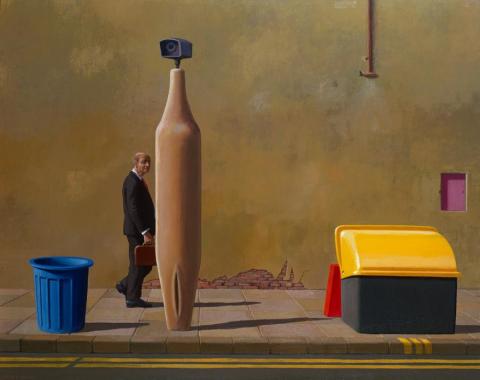MR T.S. EUGENIDES, MORNING, SHAFTESBURY AVENUE, 1978
JEFFREY SMART
oil on canvas
65.0 x 83.0 cm
signed lower left: JEFFREY SMART
Philip Bacon Galleries, Brisbane
Private collection, United States of America
Jeffrey Smart – New Paintings, Redfern Gallery, London 7 June – 4 July 1979, cat. 11
Collis, L., 'Jeffrey Smart Redfern Gallery', Art and Artists, August 1979, pp. 44–46
Quartermaine, P., Jeffrey Smart, Gryphon Books Pty Ltd, Melbourne, 1983, p. 116, cat. 730, p. 80 (illus.)
Study for Mr T. S. Eugenides, 1978, oil on canvas, 34.0 x 41.0 cm, in Quartermaine, P., Jeffrey Smart, Gryphon Books Pty Ltd, Melbourne, 1983, cat. 729
We are grateful to Stephen Rogers, Archivist for Jeffrey Smart, for his assistance with this catalogue entry.
Jeffrey Smart's interest in T.S. Eliot is long and fruitful. His 1945 solo exhibition in Adelaide included two paintings titled The Wasteland after Eliot's 1920 masterpiece The Waste Land. (Wasteland II, 1945 is now in the collection of the Art Gallery of New South Wales, Sydney.) Later, as the visual poet of the twentieth-century's urban environment, Smart's ceaseless fascination with faceless apartment blocks and roads, signinfested through the countryside, inspired the works by which we know him best. The late seventies were a highlight, witnessing the production of such masterly paintings as The Directors, 1977 in the collection of the Art Gallery of Western Australia, Perth; and the 1979-80 paintings Autobahn in the Black Forest I and II, and the three versions of The Guiding Spheres (Homage to Cézanne), all in private collections. Mr T.S. Eugenides, Morning, Shaftesbury Avenue, 1978 was painted during this fertile time, pregnant with suggestive imagery and meaning. The references to Eliot, some subtle, and others obvious, enrich the painting and reveal more of the artist than is customary.
Smart has often said that the figures in his paintings are there to give scale. Mr Eugenides is too significant for that, embodying, as he does for Eliot the depersonalization of human beings in the soulless modern business world, echoed by Smart.1 In Eliot the person of Tiresias follows hard on that of Eugenides. Again Smart follows suit. Tiresias, the celebrated mythological prophet of ancient Thebes, had been changed into a female and back again. As a result of his famous judgement that the female received ten times the greater pleasure in making love, he lost his eyesight courtesy of Juno and gained the gift of prophecy and long life via Jupiter. Eliot called Tiresias 'the most important personage in the poem', adding that 'the two sexes meet' in him.2 For Smart he is the strange hermaphroditic traffic counter with the all-seeing eye atop. While Smart in his autobiography Not Quite Straight reveals his role, he may also claim the role of oracle in modern times through the metaphor of the security camera. The autobiographical continues in the render missing from the wall, outlining the coast of South Australia.3 Of Eliot and Smart, Peter Quartermaine has written, 'He has said that what attracts him to Eliot's characters - Sweeney, Prufrock, Mr Eugenides - is that they are "fascinating, and ordinary with it". His own creation, the middle-aged, dark-suited figure who sometimes (in a nod to Eliot) appears as "Mr T.S. Eugenides", is an exercise on this theme. His familiar presence in Smart's urban landscapes reminds us that this is our world... .'4 Shaftesbury Avenue runs through London's Soho, the street kerb revealing yellow lines of no standing. It is starkly empty. Mr T.S. Eugenides, Morning, Shaftesbury Avenue, like Eliot's The Waste Land, is a dramatic monologue, at times opaque and others revealing.
1. Mr Eugenides probably first appeared by name in Smart's work in 1971 in the painting T.S. Eugenides, Piraeus and the two related drawings of 1970-71. See Jeffrey Smart Drawings and Studies 1942-2001, Australian Galleries, Melbourne, 2001, pp. 88-89
2. Eliot, T.S., The Waste Land, Boni and Liveright, New York, 1922, 'Notes' 218
3. I am grateful to Stephen Rogers, Jeffrey Smart's archivist, for pointing this out
4. Quartermaine, P., Jeffrey Smart, Gryphon Books Pty Ltd, Melbourne, 1983, p. 30
DAVID THOMAS
